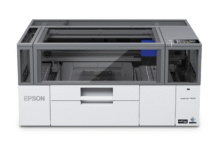Harshit Varshney’s father, Subhash Chandra Varshney, laid the foundation of Lovely Offset Printer 55 years ago in Aligarh (Uttar Pradesh), 130 km away from Delhi. On finishing college, Varshney took up the business and has seen its ups and downs before and after the Covid-19 pandemic. With the pandemic shut down on 23 March 2020, most print businesses except those in essential supply chains such as food and pharma packaging fell. Commercial printers were hit especially hard with schools, travel, entertainment, and hospitality closed but Lovely Offset is one of the small commercial printers that has survived the pandemic. Varshney speaks about the multiple factors contributing to keeping his ship afloat during the Covid-19 pandemic.
In October 2021, IPP Correspondent Girish Anshul visited Aligarh to meet and interview Harshit Varshney, a commercial printer in the middle of the city at Achal Tal, a locality known for its large Shiv Temple Achleshwar.
Indian Printer and Publisher – Covid-19 engulfed the small commercial printers, but you survived. Please share your overall experience and the challenges you faced?
Harshit Varshney – Covid-19 changed the business world. Every business shut for a few months and the tips and tricks everybody uses in business and the market changed in just a few days. There was a call by all the printers to carry on their business as both the behemoths and the tiny enterprises were all short of money. Everybody just got stuck in one place. After four months of Covid-19 in July 2020, with the first un-lockdown, business gradually started. There was a wishy-washy condition in the market, and because of no demand, none had orders to fulfil. The workers and labor were not there. The worst situations for business are why many of the small businesses are shut down.

photo IPP
Indian Printer and Publisher – What are the business tactics that have changed after the Covid-19?
Harshit Varshney – The way of doing business has taken a leaf turn. Before Covid-19, there was an ease of doing business. We bought all the raw materials on credit, and we paid the dealer in two to three months. After Covid-19, despite the lack of cash flow and shortage of money in the market, the total purchase amount had to be paid immediately. At the same time, the demand in the market is not high, so the production level is going down.
Indian Printer and Publisher – Which type of machines do you use in your plant?
Harshit Varshney – In Lovely Offset, we have a manual as well as automatic machines. We have a 4-color 20 x 30-inches offset press, that we bought from Khushi Graphics in Faridabad. Then we have automatic die-cutting and lamination machines also purchased
from Faridabad. A single color offset press is also there, and a 42-inch modern paper cutter. In packaging, we have local glueing and stitching machines.
In the pandemic situation, precautions such as on-site workers wearing PP kits, maintaining social distancing, sanitizing their hands, and daily monitoring of temperature are being taken.
Indian Printer and Publisher – What types of consumables do you use?
Harshit Varshney – We purchase local offset plates. For packaging, we use some whiteboard and primarily greyboard. Board comes from mills such as Century, Emami, Khanna, Pahal, Cheema, and Dev. For cartons, we use Shalimar glue.
Indian Printer and Publisher – Today, we see different types of packaging in the market. Which kind of packaging are you doing?
Harshit Varshney – As a packaging printer and converter, we produce as per the demand by the customer, but there is a trend in the market of window patched cartons and we do
these with 10-micron film. Our focus is to make cartons with windows and we are also planning to be more environmentally friendly.
Indian Printer and Publisher – Who are your targeted customers?
Harshit Varshney – As we know, Aligarh is famous for locks, so we are also doing lock

photo IPP
packaging –mortise lockset, padlocks, interlocks, multi-lock, and many other packs for the lock industry.
Indian Printer and Publisher – In this segment, is there a price war? How do you compete for your price from competitors?
Harshit Varshney – Price war is there in all the segments, not only in
printing. Every customer wants the product cheap and best. However, to compete, you don’t have to compromise with the quality. Even though your price is high, the customer will continue to buy your product.
Indian Printer and Publisher – Our observation is that technology is changing in the market. What are your future goals?
Harshit Varshney – As we are now in a condition to take our business to the next level, we plan to purchase Heidelberg presses in January or February 2022. We now have to move from being a small-size commercial printer to a mid-size commercial printer. “Technological change is mandatory in the business. Without technological advancement, the business will not grow, and one day your well-established business will be on its knees.”
















